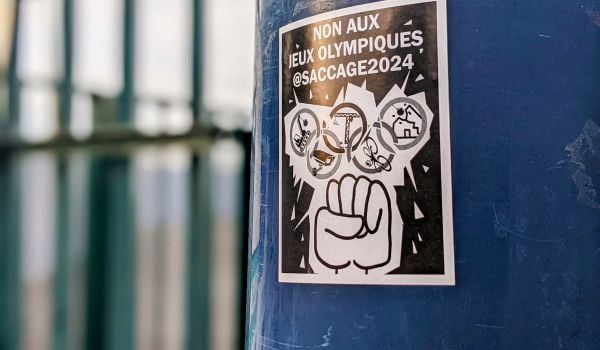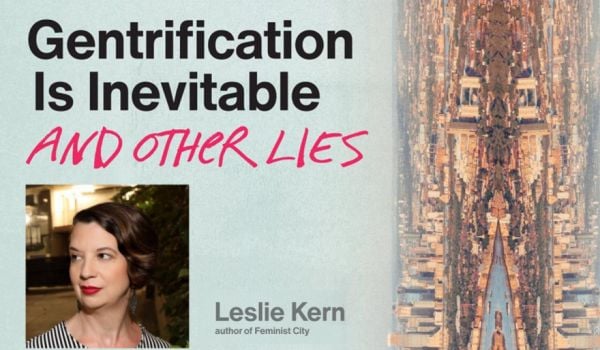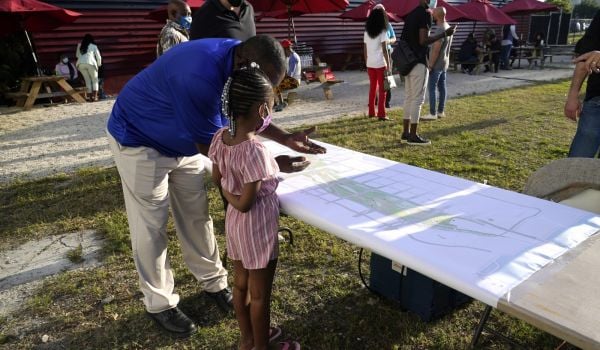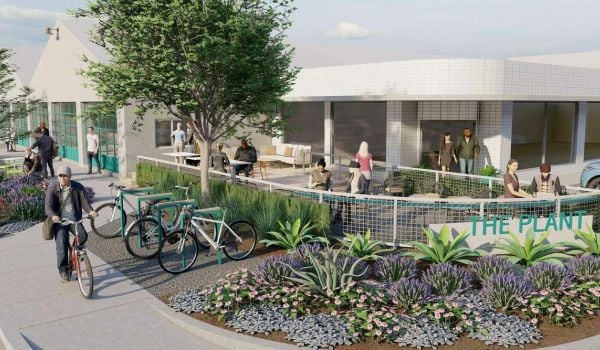The following is an excerpt from “GENTRIFIER” by John Joe Schlichtman, Jason Patch and Marc Lamont Hill. The book seeks to push the limits of the dialogue relating to the theory, policy and lived experiences of gentrification. One of the strands of this approach is to bring personal biography into the conversation, as this adapted excerpt illustrates.
It is no surprise that many conversations about ethical gentrification involve ethical consumption. When residents are willing to reflect, it is clear that the goal of ethical consumption has become very, very complicated. Brooklyn gentrifier Erin Parks shares her self-consciousness about being seen as one of “‘those educated blacks,’ most easily identified by somehow using ‘ratchet’ and ‘prosciutto’ in the same sentence.” “Walking past the Marcy projects with a full bag of Trader Joe’s groceries … I look like I belong” — even while her cousin from Hollis, Queens, reminds her that her Erykah Badu look smacks of “the new downtown Brooklyn.” She works to keep her “eyes open for neighborhood black businesses to support,” balancing the fact that who she is “clashes with the bulletproof bodega plexiglas, where members of the community stop in for their daily lotto tickets and snacks.”
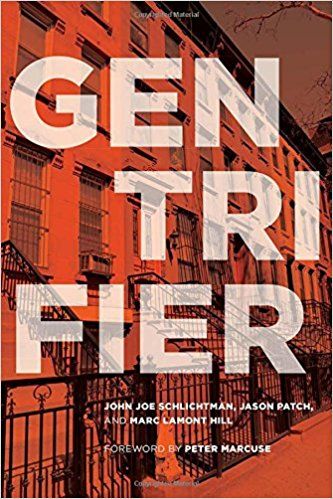
Many takes on gentrification assume the middle-class urban resident to be little more than a consumer. We are, of course, all consumers who purchase our food and clothes somewhere, yet such purchases are understood to have extra depth and present unique contradictions for the gentrifier. When the sanitation workers and construction crews stop at Starbucks in the morning, they are getting coffee, but when financial analysts stop at Starbucks in the morning, they are doing it to fulfill their very reason for being.
Dannette Lambert encourages gentrifiers to look for the “dive bar, the hole in the wall restaurant.” Another blog guide admonishes that, if “good gentrifiers” need “a nice bottle of wine or a gallon of organic milk,” they should not “necessarily assume a store doesn’t have it simply because of the presence of bulletproof glass,” but rather they should “check it out first.” The latter blog suggests that such practices limit one’s “gentrifilogical” footprint (our language—corniness intended), while the former suggests that these behaviors can actually keep a person from being a gentrifier in the first place. It can’t, of course, as Erin Parks understands. A gentrifier is simply a middle-class person who moves into a disinvested neighborhood when a critical mass of other middle-class people do the same, exerting economic, political, & social pressures upon the existing community.
The Gentrifier’s Honeytrap?
John recently saw a friend — a community organizer and academic — who is making a move from city to city. Given her penchant for cafés and a diverse offering of food, she pre-empted John, knowing his angle. “Yes, J.J., I am resigned that I am going to be a gentrifier.”
Is consumption the gentrifier’s honeytrap? While consumption becomes the raison d’être for particular groups of gentrifiers, it is also an inevitable part of the life of every gentrifier — indeed, every resident. When a person walks down streets, it is often consumption spaces that provide the motivation. This is true regardless of whether the local residents have an average income of $20,000 or $200,000. The question in a gentrifying neighborhood is whether it can sustain a place with a $2.50 breakfast special of two eggs and toast as well as a place with brunch specials and alcoholic beverages.
In John’s Golden Hill, San Diego, the answer was often yes. But, as comedian Micia Mosley implies, it is sometimes no. “So … if you have a local coffee shop where you have free wireless internet and the least expensive coffee is $2, you’re in phase one of gentrification,” began Mosley to an amused audience in New York. “And you have to ask yourself the question ‘Have I gentrified myself?’ You know darn well that bodega coffee for 50 cents is good. But you just had to roll up in there: ‘Oh no, because I need the dark roast.’ No you don’t! Get some Bustelo and work it out.”
One important aspect of the urban fabric is the small daily pleasures of community life — progressive urbanists are anxious to mention them for fear of their motives being questioned. Jason spent three, rich, fulfilling years in Sunset Park, Brooklyn, with his then-new wife, where they were close to friends, made new friends (also white and gentrifiers), and had access to a mix of bodegas (yes, serving Café Bustelo), an old Polish grocery store, taquerías, new cafés, and new restaurants. Even though Jason and Mariani were not earning much in those years — he was a graduate student and she a community college visiting professor — many of their small pleasures involved consumption. Buying fresh, warm empanadas from a street vendor; reading the newspaper at a coffee shop where the barista is the owner; saying hello to the local bodega owners early on a weekend morning. Such small purchases gave them entrée to community life.
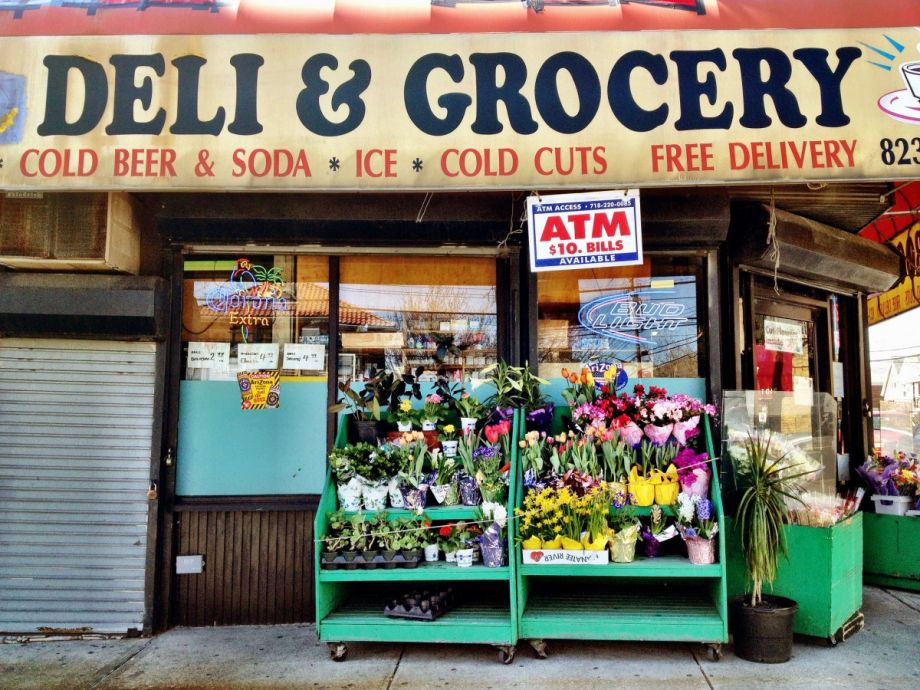
A bodega in Morris Park, NewYork (Photo by 'Nino” Eugene La Pia)
Are consuming gentrifiers “eyes on the street” à la Jane Jacobs or bourgeois imperialists à la Neil Smith’s critique? Is a love for city life about the opportunity to see friends and strangers on a daily basis, to have an interesting stream of human activity around, as Jacobs preached? Or are city streets understood as a place where diversity, authenticity and grit can be consumed as a “seasoning” while the bearers of these traits are swept away?
Thirdplace amenities are particularly important for community-minded gentrifiers. Knowing that local, independent coffee shops were in a location was a vital indicator for Jason and Mariani that they could fit in, that there were eyes on the street and public characters around. In fact, when they relocated to Providence, one way they assessed neighborhoods was where they could eat, drink and hang out; they wanted to see postings for local events and suss out the names of local clubs. They were looking for consumption places rooted in community, places that they could not find in the available alternatives: a shopping center, a small New England Main Street, or the “strip mall.”
To them, places for consumption were tied to people. Not unlike philosopher Walter Benjamin, they wanted to walk and observe folks: to people-watch in the coffee shops, restaurants and the park. Of course, we know that the first thing critical urbanists do when they break free from the confines of a scholarly or professional conference is to experience and consume the conference’s host city — its bars, its clubs, its parks, its museums. There has to be some theoretical space for such enjoyment, then: a space that cannot be boiled down to mere shallow commodification.
A Neighborhood That Feels Like Home
Between Marc’s years in gentrifying Germantown, Philadelphia, and Fort Greene, Brooklyn, he lived in Morningside Heights, Manhattan, in university-subsidized housing. While some might live in Harlem to be near Morningside Heights, to Marc it was the allure of adjacent Harlem that made his residence livable. He would answer “Harlem” when asked where in New York he lived, only to sheepishly confess “well, actually Morningside Heights” when probed further by locals. Jason joked with Marc that this was “West West Harlem.”
While cost and accessibility made living in gentrified West Harlem impossible at that time, Marc made every effort to live like a Harlem resident. Like many Americans, he saw Harlem as the Mecca for black culture and the ideal space for not only a “real” New York experience, but a real, “black” New York experience. He found pleasure — and cultural capital — in being able to walk by the historic Apollo Theater, eat at the world-famous Sylvia’s soul food restaurant, and recognize streets named after Harlem heroes such as Malcolm X and Adam Clayton Powell.

Harlem, New York (Photo by Kay)
At times, Marc was in Harlem out of practical necessity. For example, there were no black barbershops or clothing stores on his side of Morningside Park. At other times, however, the practice was linked to his desire to be identified with what he viewed as a more authentic, entrenched experience. For Marc, these notions of authenticity were linked not only to the presence of black cultural spaces such as churches, Nation of Islam mosques, and beauty supply stores, but also to recognition of more problematic signposts that some consider “real” blackness: poverty, drug addiction, and violence.
Marc did not feel his interpretation of Harlem was based merely on an abstract or fetishized conception of authenticity. He felt genuinely connected to the neighborhood based on his experiences growing up in Philadelphia. Rather than viewing himself as an outsider attempting to “go native,” he saw Harlem as an extension of his own racial and cultural identity. Harlem held a certain romance for him, but it also felt like home.
There is a danger in such rigid authenticity politics and a fallacy in framing Harlem as a “real” space unaffected by the forces of capitalism, cultural appropriation and gentrification. In a sense Harlem proper represented a crystallized case study of how capitalism overdetermines the economic, social and cultural formation of urban neighborhoods. Many of the restaurants and lounges that Marc frequented, such as Red Rooster, Corner Social and Maison Harlem, were less than 10 years old when he moved into the neighborhood. Older spots like Sylvia’s were able to thrive on the patronage of white tourists and late gentrifiers, who often took up the majority of the tables at the restaurant. It was in these spaces that Marc felt more ethically conflicted: What exactly was happening here and where did he fit?
On one hand, the presence of Marc and other upper-middle-class blacks in Harlem allowed the neighborhood to sustain its cultural, aesthetic and racial character despite the movement of native Harlemites. Without critical scrutiny, however, such a belief plays into the reductive and ultimately flawed notion that gentrification is something only white people do. In actuality, Marc and his cohorts were giving Harlem a veneer of authenticity (and indigeneity) that made it more attractive and exploitable to gentrifiers. In many ways Marc’s investment in these spaces ultimately produced the same economic consequences as that of his white counterparts.
While Marc also frequented local barbershops and bookstores that were decades old and catered to “natives” rather than gentrifiers, they too were beginning to advertise in gentrified areas in order to survive the shifting economic landscape. Still, Marc found the aesthetics and amenities of Harlem attractive enough to trump its — and his own — contradictions. Marc enjoyed Harlem.
Tackling the Thorny “Authenticity” Question
Sometimes all residents want to do is to see if they can “exhaust a place” as novelist Georges Perec sought to do in Paris or sociologist William Helmreich attempted in New York: to take in as many details as possible in daily life, to just witness a place breathing. And when residents think of a particular place breathing, be it in its current iteration or as it existed 40 years before, it is often a retail establishment that they visualize. One resident, recalling North Kenwood-Oakland of the 1950s and 1960s, said to urban sociologist Mary Pattillo, “we had, I never forget, we had a bakery called Theresa’s. We had two beautiful bakeries. We had a High-Low [Foods]. We had two beautiful butcher shops. We had a Harlan’s Grocery Store. And we had a Walgreens right there on the corner of 43rd and Berkeley.”
In a similar formulation, the old passages and cafés of French or Italian cities are seen as part of the fabric of urban life. These places of the late 19th century and 20th century were radical spaces for bringing people — strangers — together to see each other. Yet in the gentrification debates, this sense of a city, a community, as a place to wander or a setting to sit and observe is lost. It is as if for the progressive-minded such ideas automatically trigger mental images of the hip gentry-bodies in architectural renderings of a future neighborhood.
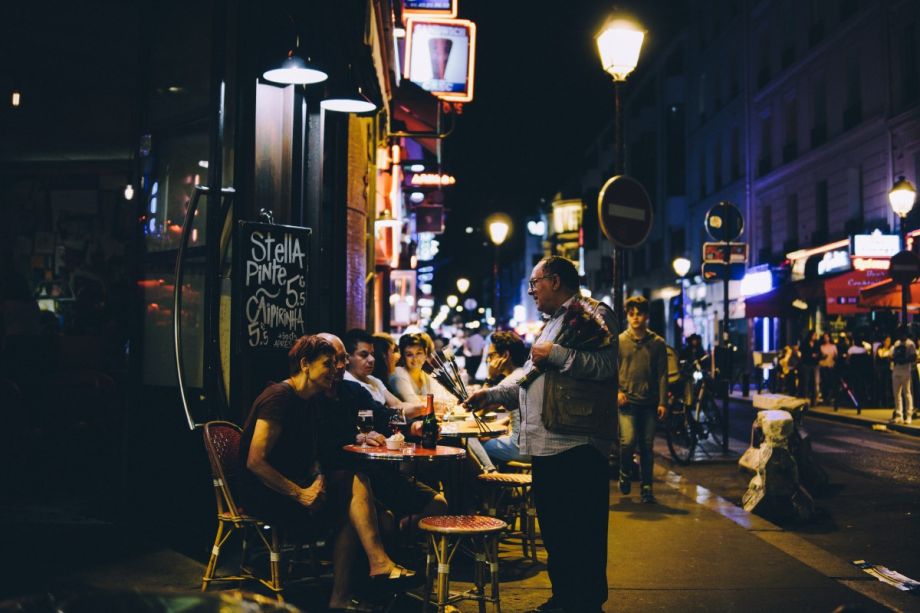
A Paris cafe (Photo by Yannis Papanastasopoulos)
Yet consumption matters, not just for buying the food to feed ourselves and garments to clothe us, but as a way for us to be social. There is no pleasure in the gentrification debates, because the very things that were considered key to urban life are inverted, treated as mechanisms for undermining a different vision of urban life. The comedian Micia Mosley is funny because she is right. The $2 cup of dark coffee is enjoyed by many in the audience — and, of course, they will continue to do so after her act.
But they know “darn well” that out of allegiance they should stick to the bodega coffee. Why, though? Is this really the level at which to fight such battles? Ironically, after reading an article about the perceived sociocultural displacement in Williamsburg caused by Pies ‘n’ Thighs restaurant, John found a receipt from the place on his and his wife’s Monique’s dresser — a Brooklyn native, she had enjoyed a meal there with a group of her Brooklyn friends during a recent trip. Given what he had just read, he almost felt the need to question her purchase there. Are we making consumption out to be more profound than we should in theory — at the same time as we scoff at how meaningless and vacuous consumption is?
Oftentimes in gentrification, there is a sentiment that the “real” neighborhood had “x” type of consumption spaces (e.g., a bodega), which are being pushed out by these “fake” types of consumption spaces (e.g., a Starbucks). The suburbs had been characterized as homogenized spaces that mask class and racial differences, where commercial activity is limited to a series of large malls, strip malls anchored by large grocery stores, and lines of drive-through fast-food restaurants. In the 1990s, a parallel set of concerns emerged in discussions of developments in cities as national and multinational chains displaced small, independent pharmacies, clothing stores, and places to eat.
But here we again run into the very thorny question of what is and what is not authentic. John recalls architectural critic Blair Kamin’s outcry when the designers of Chicago’s first Disney Store reworked the exterior etching of its building into rabbit ears. Upon sharing this tragedy in the late 1990s with urban sociologist Harvey Molotch, John recalls him quipping, “And what’s authentic Chicago? Roman columns?” “In their quick dismissal of mass taste,” said planners Susan Fainstein and David Gladstone, “many cultural critics succumb to snobbism without analyzing whether there is sufficient cause for their disdain.” Do we do the same?
Is Mi Ranchito, a local Guatemalan restaurant frequented by Jason’s family, more “authentic” — as some would suggest — because many of its customers are day laborers? What rationale underpins this? In truth, there are few things as authentic to contemporary Rhode Island as its chains of donut stores such as Dunkin’ Donuts and Sip ’n Dip: the very places that cultural critics reject. What is at stake is not authenticity. Mi Ranchito is as distinct a restaurant as those above, but no more “indigenous” or “authentic” to the neighborhood, to Providence, or to Rhode Island.
Talk of authenticity and indigeneity can lapse into what bell hooks calls “the commodification of Otherness,” which is “so successful because it is offered as a new delight, more intense, more satisfying than normal ways of doing and feeling,” as “seasoning that can liven up the dull dish that is mainstream white culture.” Wars over what belongs and what doesn’t raise the question of how “realness” and “authenticity” are awarded.
If authenticity is immediately awarded to the bodega over the coffee shop, the old deli over the new deli, the old Chinese takeout spot with plexiglas between the customer and cashier over the renovated Thai takeout spot, what are the implicit criteria being used? These implicit criteria — different from case to case — and the biases therein are important to grasp anytime a group assembles to consider plans for a neighborhood’s development. They are one component of the implicit understandings that shape our politics.
John Joe Schlichtman is an associate professor of urban sociology at DePaul University and author of “GENTRIFIER,” with Jason Patch and Marc Lamont Hill. He is a member of the 2016 Next City Vanguard class. Jason Patch is an associate professor in the Department of Anthropology and Sociology at Roger Williams University. Marc Lamont Hill is the Steve Charles Professor of Media, Cities, and Solutions at Temple University.



